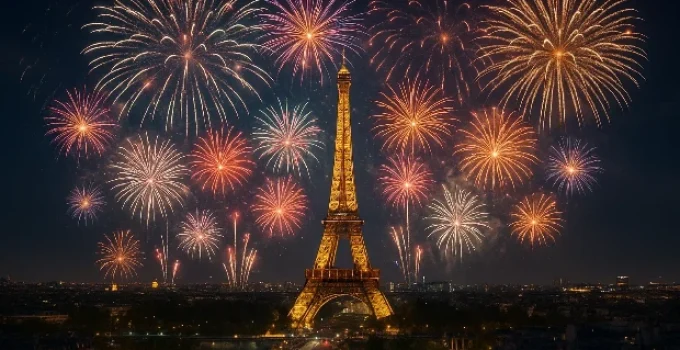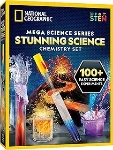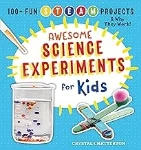What Makes Fireworks Colorful?
Fireworks are more than just bright flashes and booming sounds. Their spectacular colors come from science—specifically, chemistry and physics. But how exactly do fireworks turn into glowing greens, blazing blues, or fiery reds? In this article, we’ll explore how different elements create the colors we love in firework shows, how heat triggers those hues, and why some colors are harder to make than others.
🔎 Dive Deeper
- How Do Fireworks Get Their Colors?
- Why Does Heat Matter?
- Which Elements Make Which Colors?
- Why Are Some Firework Colors Rare?
- How Are Fireworks Designed?
- 🎯 Final Thoughts
- 📚 References
How Do Fireworks Get Their Colors?
Fireworks get their brilliant colors from metal salts—compounds that include a metal and another substance, often a chloride or nitrate. When these salts are heated during a fireworks explosion, their atoms become excited and release visible light in specific wavelengths (colors).
| Color | Metal Salt Used |
|---|---|
| Red | Strontium salts (SrCO₃) |
| Orange | Calcium salts (CaCl₂) |
| Yellow | Sodium salts (NaNO₃) |
| Green | Barium salts (BaCl₂) |
| Blue | Copper compounds (CuCl₂) |
| Purple | Strontium + Copper |
🎇 Fun Fact: According to the American Chemical Society, strontium and lithium, and barium salts are the most common metal compounds used in fireworks for red and green colors!
Why Does Heat Matter?
The temperature of the explosion plays a huge role in the brightness and clarity of the color. When fireworks explode, intense heat excites the electrons in the metal atoms. As these electrons jump to a higher energy level and then fall back, they release energy in the form of light.
- Higher heat can cause the color to become washed out or shift.
- Lower heat might not fully activate the element’s glow.
🔥 According to a report from the Chem Views Magazine, blue fireworks are especially tricky because copper compounds break down at high temperatures, making the color fade.
Which Elements Make Which Colors?
Here’s a quick breakdown of which chemicals are responsible for each color:
- Red: Strontium carbonate (SrCO₃)
- Green: Barium chloride (BaCl₂)
- Blue: Copper(I) chloride (CuCl)
- Yellow: Sodium nitrate (NaNO₃)
- Orange: Calcium chloride (CaCl₂)
- White/silver: Magnesium or aluminum powder
- Purple: A mix of strontium (red) and copper (blue)
Each of these elements emits light at specific wavelengths that the human eye perceives as different colors.
🌈 According to the U.S. Geological Survey, fireworks’ bright flashes and loud booms come from the addition of alluminum powder.
Why Are Some Firework Colors Rare?
Creating certain colors—especially blue and purple—is difficult due to the chemical stability of the compounds used:
- Blue requires just the right amount of heat. Too hot, and the color fades to white.
- Purple is made by mixing two different metal salts in just the right ratio.
- Turquoise or aqua hues are even harder because no single element produces them well.
💥 The U.S. imports over 260 million pounds of fireworks every year, with the 4th of July being the biggest celebration.
How Are Fireworks Designed?
Firework shells are carefully built to include separate compartments, each containing:
- Fuel: Usually black powder to ignite the firework.
- Oxidizers: Chemicals that provide oxygen for burning.
- Colorants: Metal salts that produce color.
- Binders: Materials that hold it all together.
- Burst charge: The part that creates the explosion.
These ingredients are packed into tiny pellets called “stars.” When a firework is launched and the stars are ignited, each star burns in a different color and pattern based on its ingredients and shape.
| Component | Purpose |
|---|---|
| Fuel | Provides energy for the explosion |
| Oxidizer | Allows the fuel to burn |
| Colorant | Determines the color of light |
| Binder | Holds everything together |
| Burst charge | Causes the star to explode outward |
🎆 According to the American Pyrotechnics Association, designing one firework can take weeks or even months of chemical testing!
🎯 Final Thoughts
So, what makes fireworks so colorful? Fireworks are both an art and a science. Behind each beautiful display is a carefully planned explosion of metal salts, heat, and chemistry. Understanding the elements that produce each color and the conditions they need to shine makes every burst in the sky that much more fascinating.
📚 References
- 💻 American Chemical Society. “Molecule of the Week – Solvent Blue 36.” ChemMatters, ACS. https://www.acs.org/molecule-of-the-week/archive/s/solvent-blue-36.html
- 📝 Chem Views Magazine. “Better Blue Fireworks.” European Journal of Inorganic Chemistry. https://www.chemistryviews.org/details/ezine/11212939/Better_Blue_Fireworks
- 💻 US Geological Survey. “What Minerals Produce the Color in Fireworks?” https://www.usgs.gov/faqs/what-minerals-produce-colors-fireworks
- 💻 Statistia. “Chart: Chinese Fireworks Light Up U.S. Skies.” https://www.statista.com/chart/14525/china-accounts-for-the-bulk-of-us-fireworks-imports/
- 💻 American Pyrotechnics Association. “APA Standard-87-1.” https://www.americanpyro.com/apa-standard-87-1
Related Products
Stunning Chemistry Set – Mega Science Kit with 100+ Easy Experiments
This kit includes all materials needed to conduct 15 stunning chemistry experiments, including building an underwater volcano, create a geyser, and more! Plus a bonus experiment guide with 85+ additional experiments that can all be done with common household items.
Awesome Science Experiments for Kids: 100+ Fun STEM / STEAM Projects and Why They Work
The ultimate science experiment book for kids! 100+ hands-on projects to get kids ages 5 to 10 excited about science.
📌 Learn More About Chemical Reactions
- What Is a Chemical Reaction?🔥20 Real Life Examples That Prove Chemistry Is All Around You
- What Happens If You Mix Baking Soda and Vinegar? 🧪The Science Behind the Fizz
- Is Burning Wood a Chemical Change? 🔥The Science Behind Fire, Ash, and Transformation
- What Makes a Glow Stick Glow?🔥The Cool Chemistry Behind the Glow in the Dark Magic
- Why Does Iron Rust Over Time? 🌧️ The Science of Metal Decay Uncovered


